November 12, 2020
From the Vault: Baby Estelle
A surprising tale of espionage and intrigue
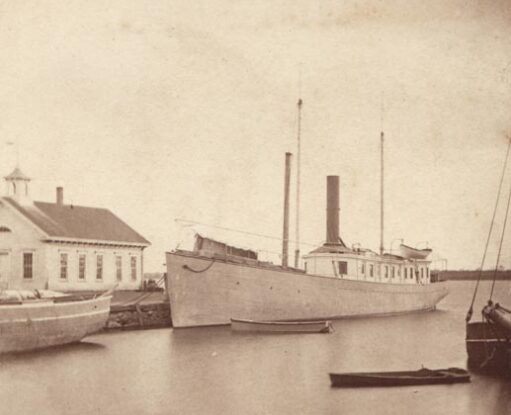
By Carlton J. Pinheiro
originally published in 1980

In May, 1877, John B. Herreshoff received an order from Herman Kobbe, a New York lawyer, for a steamer capable of considerable speed. The requirements were that the boat was to be built on a crash schedule with a bonus for fast delivery. The vessel was to be 120 feet long with a 16 foot beam and capable of 16 m.p.h. speed for three hours trial.
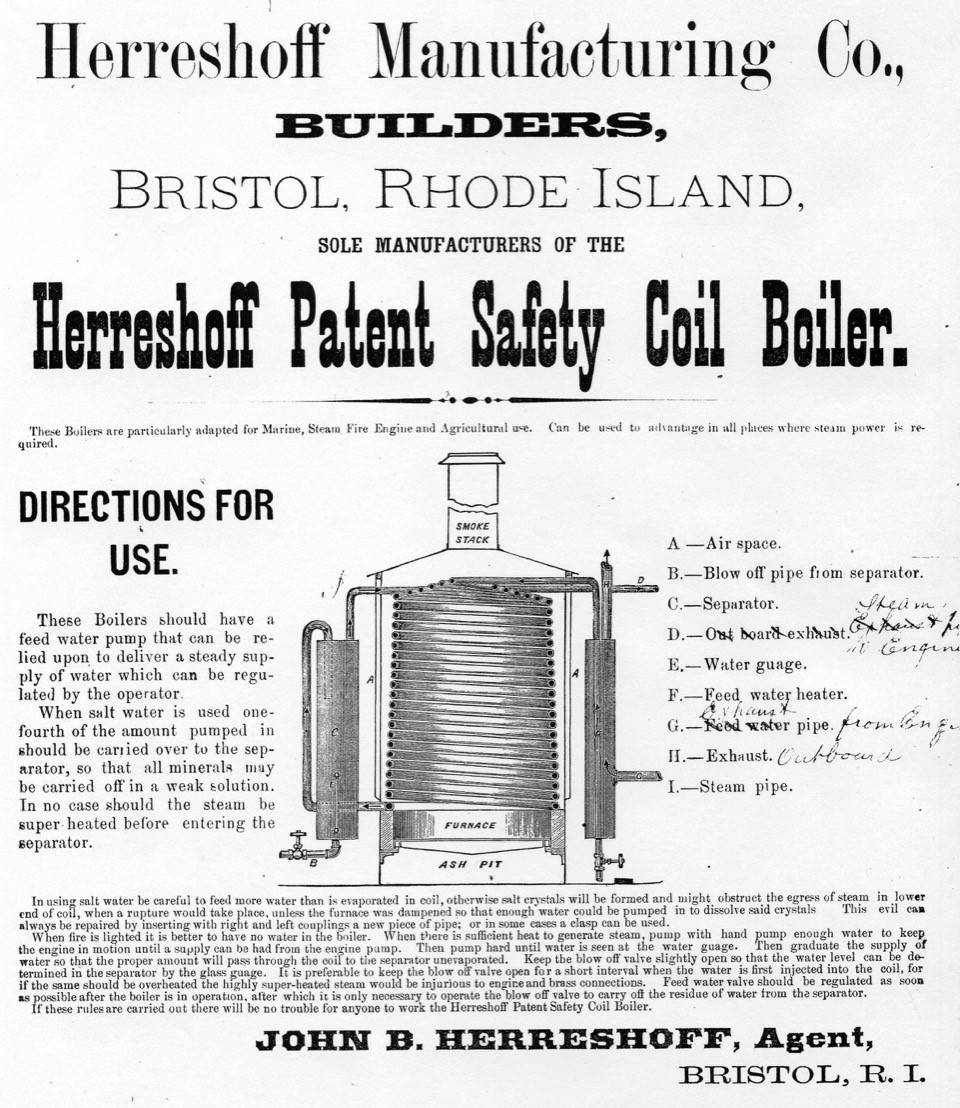
John’s younger designer brother, Nathanael G. Herreshoff, eventually received leave from the Corliss Company to make the model and drawings for the vessel and the machinery. The compound condensing engine was made at the Rhode Island Locomotive Company in Providence. A coil type boiler, designed by another brother, James B. Herreshoff, was built at Bristol.
As the Bristol yard of J.B.’s was then too small, the hull was built under contract by Job Terry in Fall River and was ready in early September. J.B. towed ESTELLE, as she was called, to Bristol with one of his 40 foot launches and immediately put the engine and boiler on board at the Herreshoff Yard. The new vessel was hauled out at Skinner and Stanton’s Marine railway by the Railroad Station (near Oliver and Thames Streets) and a large bronze rudder and other pieces of equipment were installed in late October when dock trials were made.
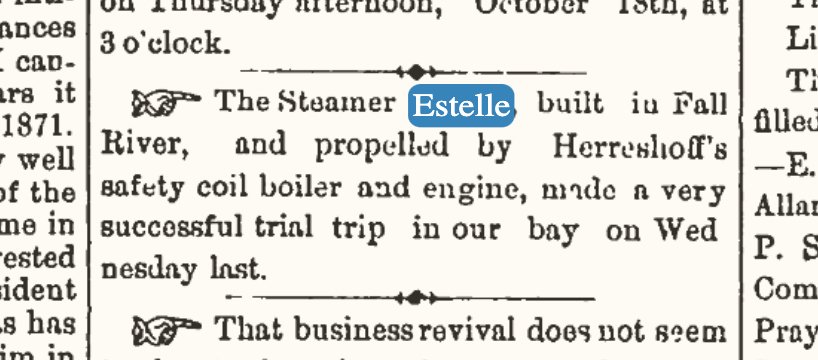
According to the Bristol Phoenix, she made her preliminary [sic, this was not the first] trial trip on the 30th of October when she cruised at a rate of 50 miles in three consecutive hours and could have increased her speed. The cabin had two staterooms, one with four, and the other with two berths. The hull was divided into storerooms and coal bunkers. The trial run down the bay and through Newport Harbor was made by turning the south end of Goat Island. The bronze rudder casting gave out and was completely lost according to Mr. Nat’s recollection years later, but the Herreshoffs only stopped a few times to anchor and get the vessel on course and continued home. East of Prudence Island, a Bristol sloop assisted the ESTELLE to the Herreshoff Yard. A new rudder was made and everything was in readiness for the final delivery trial in late November.

The board of inspectors of steam boilers had refused a certificate on the grounds that her boiler was larger than allowed by law and this was holding up her clearance papers. The problem was compounded by the fact that the U.S. Revenue Cutter SAMUEL DEXTER under Captain Carson had arrived in Bristol Harbor on November 20th and had been under orders from the treasury department to watch the new steamer. Just before the final trial, the DEXTER anchored close to the ESTELLE with orders not to let her leave the dock. The mystery then began to unfold. The reason for the strict day and night watch was that charges had been brought by the Spanish minister that Mr. Kobbe was an agent for Cuban insurgents and the ESTELLE was intended as an arms carrier. The revolt against Spanish rule had been raging for nine years and the Cuban revolutionaries needed a fast arms carrier.
In December, the government had "received damaging evidence of the ESTELLE’s probable business and destination." By mid-December a telegram announced that the Treasury Department would probably give the steamer full papers, and that the responsibility of having her watched and detained would rest with the State Department. Captain Carson was anxious to get his watch completed because a DEXTER officer had been onboard when Captain Nat had a dock trial to determine the time it took to raise steam and start the engine from the point of lighting the fire. The officer had reported that this was all done in the remarkable time of 8 minutes. This so impressed Captain Carson that instead of the DEXTER laying with its fires banked, they laid with fires spread and steam up at all times, thus using up a good deal of coal.
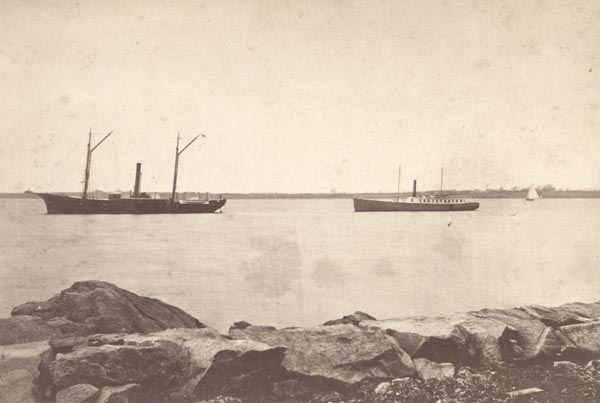
Before Christmas ESTELLE made her final trip from Bristol to Brenton’s Reef Light Ship, and then some sixty miles out to sea, and returned. Supervising Inspector C.E. Emery inspected the coil boiler. The government was represented by Collector A.S. DeWolf, Capt. Carson, Chief Engineer Harrison, and Lieutenant Slamm of the DEXTER, who were armed. Nat Herreshoff had charge of running the boat and machinery with William Torry as fireman. Charles Herreshoff did the steering and Raymond Perry and Dr. Neylan were guests. The owners were represented by their attorney and a rough looking Spaniard who was supposed to skipper the steamer when it was turned over. The ESTELLE, making her contract speed of 16 m.p.h. and then some, was accepted by the agent and paid for. Immediately, she was seized by the U.S. Treasury, part of her engine was take as insurance against leaving, and was then tied at the Bristol Wharf.
In January, 1878, U.S. Marshal Coggeshall made formal seizure under orders from the President. She was towed to Steamboat Wharf and placed under the charge of Thomas J. Usher, Esq., who was appointed keeper. The DEXTER departed Bristol in mid-January, released from her cloak-and-dagger duty. In June, 1878, the ESTELLE was released from custody. Mr. Kobbe then sold her to Albiance H. Brown of Washington, D.C. She was then employed in carrying the U.S. Mail between Mount City, Louisiana, and Indianola, Texas. Ultimately she became a tow boat at the mouth of the Mississippi, and was able to tow two or three ships at a time, faster than any of the area tugs. After some years of service, she was burned and lost in the Gulf of Mexico.

A 2020 Post Script
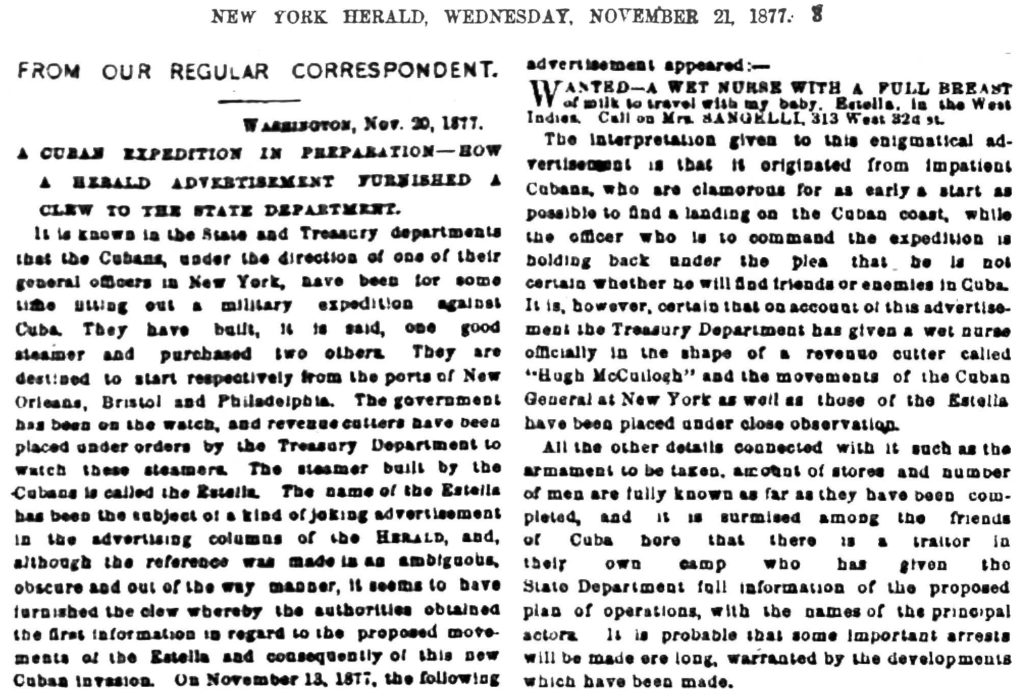
In the four decades since this piece was first published, a few additional items of note have come to light. Moreover, our ability to publish digitally allows us to bring greater context to the story for those who wish to learn more. We have linked elements of interest to external articles where relevant above. Now that so many digitized newspaper archives are available online, we have also been able to collect many of the articles covering the ESTELLE affair, and even the original coded ad in part cited as tipping off the authorities. The ESTELLE story received quite a bit of attention in the press throughout her detention, appearing in the New York Herald, the Tribune, and even the New York Times on several occasions as well as in the Bristol Phoenix.
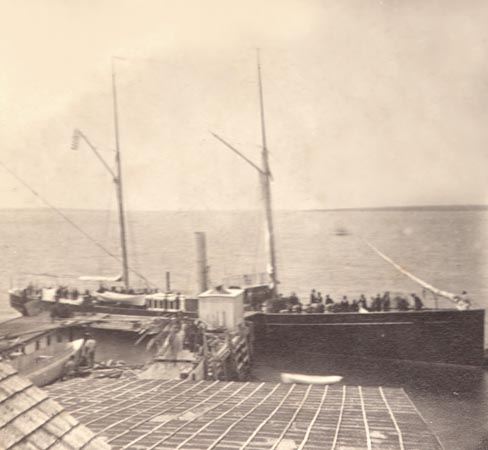
ESTELLE was a vessel of consequence for the Herreshoff brothers, and not just because of all the press attention she garnered. The following year, J.B.H. got an order for another vessel, the CLARA (HMCo. #39). Ironically, it was the Spanish government in Cuba who ordered CLARA, having been suitably impressed by ESTELLE's performance and wanting a gunboat of their own to beat ESTELLE's speed. It was this very order that prompted N.G.H. to finally leave Corliss and join with J.B.H. to form HMCo. in 1878.

The final and perhaps most exciting recent discovery from the museum's point of view is that the half model for ESTELLE still exists! It was not a part of the model collection from Love Rocks that was brought to HMM and installed in the Nathanael G. Herreshoff Model Room in the late 1990s and its whereabouts were unknown. However, two years ago we were very excited to learn - thanks to a post by an intern at the Rhode Island Historical Society and a tip from the HCR - that it was actually gifted to RIHS in 1981 by the Haffenreffer family. This suggests that the model may still have been in the HMCo. offices at the time that the company closed down in 1945, and at which point HMCo. was under Haffenreffer ownership. It is possible ESTELLE's significance to the founding of HMCo. was the reason for its continued display in the offices, rather than in N.G.H.'s collection of models in his own home. We are delighted that this very significant piece of Herreshoff history still exists today, and just up the road from us too!
